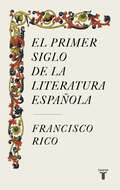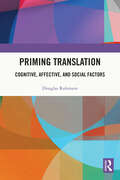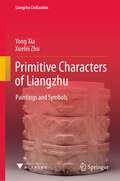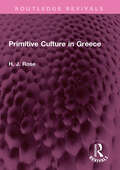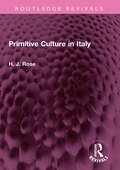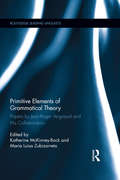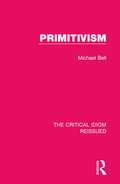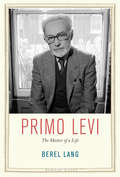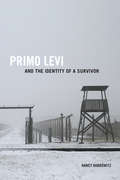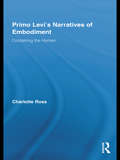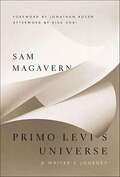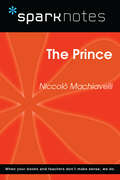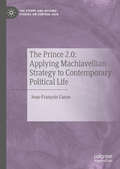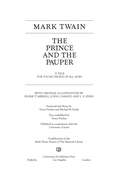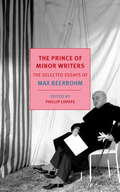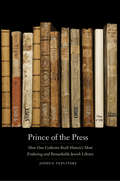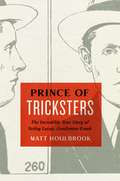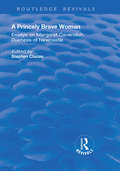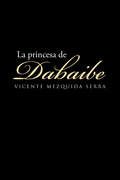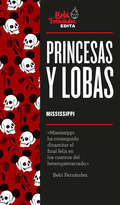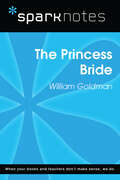- Table View
- List View
El primer siglo de la literatura española
by Francisco RicoLa literatura española medieval, expuesta por una de las voces con mayor autoridad en lengua y literatura españolas. Una obra fundamental en el campo de las humanidades. A lo largo de los siglos, el ser humano ha experimentado con las posibilidades estéticas y expresivas del lenguaje, y las ha puesto al servicio de la dimensión primordial de la vida cotidiana y la historia de los pueblos a través del arte de contar. En esta obra imprescindible, Francisco Rico indaga en diversos géneros medievales para comprender las raíces de la literatura española. Su historia no es unívoca ni lineal; formas como la canción trovadoresca, los cantares de gesta o la poesía didáctica florecieron a raíz del contacto directo con otras tradiciones. Nuestra literatura creció desde el principio enlazada a otras culturas. El primer siglo de la literatura española es un análisis exhaustivo del modo en que las actitudes primarias y universales del ser humano se reflejan en el desarrollo de nuestras letras y nos permiten entender sus orígenes más inciertos.
Priming Translation: Cognitive, Affective, and Social Factors
by Douglas RobinsonThis innovative volume builds on Michael S. Gazzaniga’s Interpreter Theory toward radically expanding the theoretical and methodological scope of translational priming research. Gazzaniga’s Interpreter Theory, based on empirical studies carried out with split-brain patients, argues for the Left-Brain Interpreter, a module in the brain’s left hemisphere that seeks to make sense of their world based on available evidence—and, where no evidence is available, primed by past memories, confabulates coherence. The volume unpacks this idea in translation research to test whether translators are primed to confabulate by the LBI in their own work. Robinson investigates existing empirical research to test hypotheses on the translational links between the LBI and cognitive priming, the Right-Brain Interpreter and affective priming, and the Collective Full-Brain Interpreter and social priming. Taken together, the book seeks to open translational priming studies up to the full range of cognitive, affective, and social primes and to prime cognitive translation researchers to implement this broader dynamic in future research. This book will be of interest to scholars in translation and interpreting studies, especially those working in cognitive translation and interpreting studies.
Primitive Characters of Liangzhu: Paintings and Symbols (Liangzhu Civilization)
by Yong Xia Xuefei ZhuThis book mainly focuses on the roles of engraved symbols and ornamentation in Liangzhu culture. It categorizes the engraved symbols discovered in Liangzhu culture as means of ideographical expression and decoration, aspects that are explored in detail. Further, the engraved symbols and ornamentation are subdivided in terms of certain similarities, including the dragon and bird systems. A separate chapter is especially designed to help readers appreciate the typical paintings and symbols in selected objects and vessels. In this way, the book seeks to analyze and generate a particular formula so as to explore patterns in the thinking of Liangzhu’s people, thus deciphering the spiritual code of the Liangzhu world.
Primitive Culture in Greece (Routledge Revivals)
by H. J. RoseFirst published in 1925, Primitive Culture in Greece dispassionately reviews the claim that the Greeks were ‘heathen’ and asks how much of the savage ancestry was left in the classical Greek. In doing so it traces a historical continuity from the barbaric invasions of Greece to its later emergence of a classical culture. It is not written merely for the specialist, and assumes no technical knowledge, but simply an interest in one of the most remarkable civilizations of the world.
Primitive Culture in Italy (Routledge Revivals)
by H. J. RoseFirst published in 1926, Primitive Culture in Italy intends to determine to what extent there survived, in the ancient civilization with which it deals, any characteristic features of savage life and thought. The primitive man provides an ideal beginning to study the long upward progress of humanity. This book is not for the specialist, but for the general reader who wishes to know something of the beginnings of a great and notable civilization, the effects of which are still to be seen in our modern culture.
Primitive Elements of Grammatical Theory: Papers by Jean-Roger Vergnaud and His Collaborators (Routledge Leading Linguists #20)
by Jean-Roger VergnaudThis book is a compilation of manuscripts and publications from 2001-2010 by Jean-Roger Vergnaud, in collaboration with colleagues and students. This work is guided by the scientific belief that broader mathematical principles should guide linguistic inquiry, as they guide classical biology and physics. From this, Vergnaud’s hypotheses take the representation of the computational component of language to a more abstract level: one that derives constituent structure. He treats linguistic features as primitives, and argues that a 2 x n matrix allows for multiple discrete dimensions to represent symmetries in linguistic features and to derive the fabric of syntax (and perhaps of phonology as well). Three primary research questions guide the core of these papers. (A) Methodologically, how can broadly defined mathematical/cognitive principles guide linguistic investigation? (B) To what extent do general mathematical principles apply across linguistic domains? What principles guide computation at different levels of linguistic structure (phonology, metrical structure, syntax)? (C) How is the computational domain defined? In these manuscripts, Vergnaud’s goal is not to radically depart from the Minimalist Program within generative grammar, but rather to take the underlying goal of the generative program and bring it to an even more general scientific level. The themes of symmetry and periodicity in this book reflect his goal of scientific progress in linguistics, and he has opened the doors to new exploration of old empirical problems in linguistics that may, someday, have deeper biological and physical explanations through the theory presented in this publication.
The Primitive, the Aesthetic, and the Savage: An Enlightenment Problematic
by Tony C. BrownTony C. Brown examines &“the inescapable yet infinitely troubling figure of the not-quite-nothing&” in Enlightenment attempts to think about the aesthetic and the savage. The various texts Brown considers—including the writings of Addison, Rousseau, Kant, and Defoe—turn to exotic figures in order to delimit the aesthetic, and to aesthetics in order to comprehend the savage.In his intriguing exploration Brown discovers that the primitive introduces into the aesthetic and the savage an element that proves necessary yet difficult to conceive. At its most profound, Brown explains, this element engenders a loss of confidence in one&’s ability to understand the human&’s relation to itself and to the world. That loss of confidence—what Brown refers to as a breach in anthropological security—traces to an inability to maintain a sense of self in the face of the New World. Demonstrating the impact of the primitive on the aesthetic and the savage, he shows how the eighteenth-century writers he focuses on struggle to define the human&’s place in the world. As Brown explains, these authors go back again and again to &“exotic&” examples from the New World—such as Indian burial mounds and Maori tattooing practice—making them so ubiquitous that they come to underwrite, even produce, philosophy and aesthetics.
Primitivism (The Critical Idiom Reissued #19)
by Michael BellFirst published in 1972, this books examines the subject of primitivism through the study of the work of a number of major writers, including D. H. Lawrence, Herman Melville, Joseph Conrad, T. S. Eliot and James Joyce. It looks at the variety of definitions and uses of primitivism and how the idea has changed over time as well as with each writer. In doing so, it is argued that primitivism denotes, or arises from, a sense of crisis in civilization and it is born of the interplay between the civilized self and the desire to reject or transform it. This book will be of interest to those studying modern literature.
Primo Levi
by Ariella Lang Berel LangIn 1943, twenty-four-year-old Primo Levi had just begun a career in chemistry when, after joining a partisan group, he was captured by the Italian Fascist Militia and deported to Auschwitz. Of the 650 Italian Jews in his transport, he was one of fewer than 25 who survived the eleven months before the camp's liberation. Upon returning to his native Turin, Levi resumed work as a chemist and was employed for thirty years by a company specializing in paints and other chemical coatings. Yet soon after his return to Turin, he also began writing--memoirs, essays, novels, short stories, poetry--and it is for this work that he has won international recognition. His first book, If This Is a Man, issued in 1947 after great difficulty in finding a publisher, remains a landmark document of the twentieth century. Berel Lang's groundbreaking biography shines new light on Levi's role as a major intellectual and literary figure--an important Holocaust writer and witness but also an innovative moral thinker in whom his two roles as chemist and writer converged, providing the "matter" of his life. Levi's writing combined a scientist's attentiveness to structure and detail, an ironic imagination that found in all nature an ingenuity at once inviting and evasive, and a powerful and passionate moral imagination. Lang's approach provides a philosophically acute and nuanced analysis of Levi as thinker, witness, writer, and scientific detective.
Primo Levi and the Identity of a Survivor
by Nancy HarrowitzPrimo Levi (1919–1987) was an Italian chemist, writer, and Holocaust survivor who used a combination of testimony, essays, and creative writing to explore crucial themes related to the Shoah. His voice is among the most important to emerge from this dark chapter in human history. In Primo Levi and the Identity of a Survivor, Nancy Harrowitz examines the complex role that Levi’s Jewish identity played in his choices of how to portray his survival, as well as in his exposition of topics such as bystander complicity. Her analysis uncovers a survivor’s shame that deeply influenced the personas he created to recount his experiences. Exploring a range of Levi’s works, including Survival at Auschwitz and lesser-known works of fiction and poetry, she illustrates key issues within his development as a writer. At the heart of Levi’s discourse, Harrowitz argues, lies a complex interplay of narrative modes that reveals his brilliance as a theorist of testimony.
Primo Levi's Narratives of Embodiment: Containing the Human (Routledge Studies In Twentieth-century Literature Ser. #16)
by Charlotte RossThis innovative reading of Primo Levi’s work offers the first sustained analysis in English of his representations of bodies and embodiment. Discussion spans the range of Levi’s works — from testimony to journalism, from essays to science fiction stories — identifying and tracing multiple narratives of embodiment and disembodiment across his oeuvre. These narratives range from the abject, disembodied condition of prisoners in Auschwitz, to posthuman or cyborg individuals, whose bodies merge with technological devices. Levi’s representations of bodies are explored in relation to theories of embodiment and posthumanism, bringing his work into new dialogue with critical discourses on these issues. Taking inspiration from Levi’s definition of the human being as a constructor of containers, as well as from the recurring references to both material and metaphorical containing structures in his work, the book suggests that for Levi, embodiment involves constant negotiations of containment. He depicts the complex relationships between physical and social bodies, the material and the immaterial self, the conscious and unconscious subject, the organic and the technologically-enhanced body, engaging with evolving understandings of the boundaries of the body, the self, and the human.
Primo Levi's Universe: A Writer's Journey
by Sam MagavernPrimo Levi is best known as a memoirist of Auschwitz, but he was also a scientist, fiction writer, and poet: in short, a Renaissance man. Primo Levi's Universe offers a multi-faceted portrait of the heroic man who turned the concentration camp experience into beautiful yet terrifying literature. Over time, Levi developed an original world-view which he conveyed in his writing. Through careful readings of Levi's works, Sam Magavern finally does justice to his calm rationality, dark poetry, essential beliefs and wit. Levi's art and life are inextricably intertwined, and this book presents them together, allowing each to shed light on the other.
The Prince (SparkNotes Philosophy Guide)
by SparkNotesThe Prince (SparkNotes Philosophy Guide) Making the reading experience fun! SparkNotes Philosophy Guides are one-stop guides to the great works of philosophy–masterpieces that stand at the foundations of Western thought. Inside each Philosophy Guide you&’ll find insightful overviews of great philosophical works of the Western world.
The Prince 2.0: Applying Machiavellian Strategy to Contemporary Political Life (The Steppe and Beyond: Studies on Central Asia)
by Jean-François CaronThis Pivot updates the ideas of the famous political philosopher from the Italian Renaissance, Machiavelli, for the 21st century, using case studies from the West and from Kazakhstan to demonstrate the utility of Machiavelli's ideas for contemporary political life. In truth, Machiavelli's ideas have never lost their value. Although "Machiavellian" as an adjective tends to describe amoral cynicism in contemporary usage, Machiavelli's ideas were deeply ethical and oriented towards achieving long-term goals. Contemporary readers may be put off by medieval language and examples, misled into believing Machiavelli speaks to a different age; and yet the author here explores how Machiavellian strategy can be of value— ethical as well as practical—in the 21st century.
The Prince and the Pauper
by John J. Harley Frank T. Merrill Mark Twain Victor Fischer Michael B. Frank"What am I writing? A historical tale of 300 years ago, simply for the love of it." Mark Twain's "tale" became his first historical novel, The Prince and the Pauper, published in 1881. Intricately plotted, it was intended to have the feel of history even though it was only the stuff of legend. In sixteenth-century England, young Prince Edward (son of Henry VIII) and Tom Canty, a pauper boy who looks exactly like him, are suddenly forced to change places. The prince endures "rags & hardships" while the pauper suffers the "horrible miseries of princedom." Mark Twain called his book a "tale for young people of all ages," and it has become a classic of American literature. The first edition in 1881 was fully illustrated by Frank Merrill, John Harley, and L. S. Ipsen. The boys in these illustrations, Mark Twain said, "look and dress exactly as I used to see them cast in my mind. . . . It is a vast pleasure to see them cast in the flesh, so to speak." This Mark Twain Library edition exactly reproduces the text of the California scholarly edition, including all of the 192 illustrations that so pleased the author.
The Prince of Minor Writers
by Phillip Lopate Max BeerbohmAN NYRB CLASSICS ORIGINAL Virginia Woolf called Max Beerbohm "the prince" of essayists, F. W. Dupee praised his "whim of iron" and "cleverness amounting to genius," while Beerbohm himself noted that "only the insane take themselves quite seriously." From his precocious debut as a dandy in 1890s Oxford until he put his pen aside in the aftermath of World War II, Beerbohm was recognized as an incomparable observer of modern life and an essayist whose voice was always and only his own. Here Phillip Lopate, one of the finest essayists of our day, has selected the finest of Beerbohm's essays. Whether writing about the vogue for Russian writers, laughter and philosophy, dandies, or George Bernard Shaw, Beerbohm is as unpredictable as he is unfailingly witty and wise. As Lopate writes, "Today . . . it becomes all the more necessary to ponder how Beerbohm performed the delicate operation of displaying so much personality without lapsing into sticky confession."
Prince of the Press: How One Collector Built History's Most Enduring and Remarkable Jewish Library
by Joshua TeplitskyThe story of one of the largest collections of Jewish books, and the man who used his collection to cultivate power, prestige, and political influence David Oppenheim (1664–1736), chief rabbi of Prague in the early eighteenth century, built an unparalleled collection of Jewish books and manuscripts, all of which have survived and are housed in the Bodleian Library at Oxford. His remarkable collection testifies to the myriad connections Jews maintained with each other across political borders, and the contacts between Christians and Jews that books facilitated. From contact with the great courts of European nobility to the poor of Jerusalem, his family ties brought him into networks of power, prestige, and opportunity that extended across Europe and the Mediterranean basin. Containing works of law and literature alongside prayer and poetry, his library served rabbinic scholars and communal leaders, introduced old books to new readers, and functioned as a unique source of personal authority that gained him fame throughout Jewish society and beyond. The story of his life and library brings together culture, commerce, and politics, all filtered through this extraordinary collection. Based on the careful reconstruction of an archive that is still visited by scholars today, Joshua Teplitsky’s book offers a window into the social life of Jewish books in early modern Europe.
Prince of Tricksters: The Incredible True Story of Netley Lucas, Gentleman Crook
by Matt HoulbrookMeet Netley Lucas, Prince of Tricksters--royal biographer, best-selling crime writer, and gentleman crook. In the years after the Great War, Lucas becomes infamous for climbing the British social ladder by his expert trickery--his changing names and telling of tales. An impudent young playboy and a confessed confidence trickster, he finances his far-flung hedonism through fraud and false pretenses. After repeated spells in prison, Lucas transforms himself into a confessing "ex-crook," turning his inside knowledge of the underworld into a lucrative career as freelance journalist and crime expert. But then he's found out again--exposed and disgraced for faking an exclusive about a murder case. So he reinvents himself, taking a new name and embarking on a prolific, if short-lived, career as a royal biographer and publisher. Chased around the world by detectives and journalists after yet another sensational scandal, the gentleman crook dies as spectacularly as he lived--a washed-up alcoholic, asphyxiated in a fire of his own making. The lives of Netley Lucas are as flamboyant as they are unlikely. In Prince of Tricksters, Matt Houlbrook picks up the threads of Lucas's colorful lies and lives. Interweaving crime writing and court records, letters and life-writing, Houlbrook tells Lucas's fascinating story and, in the process, provides a panoramic view of the 1920s and '30s. In the restless times after the Great War, the gentlemanly trickster was an exemplary figure, whose tall tales and bogus biographies exposed the everyday difficulties of knowing who and what to trust. Tracing how Lucas both evoked and unsettled the world through which he moved, Houlbrook shows how he prompted a pervasive crisis of confidence that encompassed British society, culture, and politics. Taking readers on a romp through Britain, North America, and eventually into Africa, Houlbrook confronts readers with the limits of our knowledge of the past and challenges us to think anew about what history is and how it might be made differently.
A Princely Brave Woman: Essays on Margaret Cavendish, Duchess of Newcastle
by Stephen ClucasThis title was first published in 2003. This collection of essays presents a variety of new approaches to the oeuvre of Margaret Cavendish, Duchess of Newcastle, one of the most influential and controversial women writers of the seventeenth century. Reflecting the full range of Cavendish's output - which included poetry, drama, prose fictions, orations, and natural philosophy - these essays re-assess Cavendish's place in seventeenth- century literature and philosophy. Whilst approaching Cavendish's work from a range of critical (and disciplinary) perspectives, the authors of these essays are united in their commitment to recovering her writings from their frequent characterisation as "eccentric" or "idiosyncratic", and aim to present her work as historically legible within the cultural contexts in which they were written. The "Mad Madge" of literary legend and tradition is re-written as a bold, innovative and experimental creator of a female authorial voice, and as a thinker vitally in contact with the intellectual currents of her age.
La princesa de Dabaibe
by Vicente Mezquida SerraUn canto al mestizaje. En un breve, a la vez que apasionante relato histórico sobre la leyenda de Anayansi, la figura de Balboa y el avistamiento del Mar del Sur.
Princesas y lobas
by Marta MississippiSe acabaron las princesas que esperan a príncipes y besan a ranas. Se acabaron las princesas encerradas. No es que nos hayan salido feministas, es que nos han salido de la jaula. Un libro de la colección «Bebi Edita». Que los cuentos que nos cuentan son mentira, lo sabíamos desde hace tiempo. Pero, ¿por qué se repite siempre la misma historia, en las películas, en los libros, en las canciones? Basta ya de princesas, castillos y zapatitos que aprietan demasiado. Marta Mississippi, junto al análisis inflamable de Bebi, trae el final de la historia: ahora el cuento es tuyo. *** @SrtaBebi empezó incendiando las redes con más de 615.000 seguidores. Poco después inflamó libros: Indomable lleva más de 85.000 ejemplares vendidos. Ahora llega para editar su propia colección: «Bebi Edita». Ella decide autores, textos y añadesu personal y único punto de vista en un prólogo y comentarios que acompañan a cada libro de la colección. Para seguir quemando.
The Princess Bride (SparkNotes Literature Guide Series)
by SparkNotesPrincess Bride (SparkNotes Literature Guide) by William Goldman Making the reading experience fun! Created by Harvard students for students everywhere, SparkNotes is a new breed of study guide: smarter, better, faster. Geared to what today's students need to know, SparkNotes provides: *Chapter-by-chapter analysis *Explanations of key themes, motifs, and symbols *A review quiz and essay topicsLively and accessible, these guides are perfect for late-night studying and writing papers
The Princess Bride and Philosophy: Inconceivable!
by Richard Greene Rachel Robison-GreeneThe Princess Bride is the 1987 satirical adventure movie that had to wait for the Internet and DVDs to become the most quoted of all cult classics. <P><P> The Princess Bride and Philosophy is for all those who have wondered about the true meaning of "Inconceivable!," why the name "Roberts" uniquely inspires fear, and whether it's truly a miracle to restore life to someone who is dead, but not necessarily completely dead. The Princess Bride is filled with people trying to persuade each other of various things, and invites us to examine the best methods of persuasion. It's filled with promises, some kept and some broken, and cries out for philosophical analysis of what makes a promise and why promises should be kept. It's filled with beliefs which go beyond the evidence, and philosophy can help us to decide when such beliefs can be justified. It's filled with political violence, both by and against the recognized government, and therefore raises all the issues of political philosophy. Westley, Buttercup, Prince Humperdinck, Inigo Montoya, the giant Fezzik, and the Sicilian Vizzini keep on re-appearing in these pages, as examples of philosophical ideas. Is it right for Montoya to kill the six-fingered man, even though there is no money in the revenge business? What's the best way to deceive someone who knows you're trying to deceive him? Are good manners a kind of moral virtue? Could the actions of the masked man in black truly be inconceivable even though real? What does ethics have to say about Miracle Max's pricing policy? How many shades of meaning can be conveyed by "As You Wish"?
Princess Pig (Bright Owl Books)
by Molly CoxePig and Twig are playing Princess. Pig gets three wishes. But she wants more! This fun photographic easy-to-read story features the short "i" vowel sound. Kane Press's new series of super simple easy-to-reads, Bright Owl Books, launches with Molly Coxe's five photographic stories, which feature the short vowel sounds and are each only around 100 words. These irresistibly silly stories help kids learn to read through repetition and by teaching the basic building blocks of reading—vowel sounds—giving kids the perfect start on educational success.
The Princeton Anthology of Writing: Favorite Pieces by the Ferris/McGraw Writers at Princeton University
by John McPhee & Carol RigolotIn 1957--long before colleges awarded degrees in creative nonfiction and back when newspaper writing's reputation was tainted by the fish it wrapped--Princeton began honoring talented literary journalists. Since then, fifty-nine of the finest, most dedicated, and most decorated nonfiction writers have held the Ferris and McGraw professorships. This monumental volume harbors their favorite and often most influential works. Each contribution is rewarding reading, and collectively the selections validate journalism's ascent into the esteem of the academy and the reading public. Necessarily eclectic and delightfully idiosyncratic, the fifty-nine pieces are long and short, political and personal, comic and deadly serious. Students will be provoked by William Greider's pointed critique of the democracy industry, eerily entertained by Leslie Cockburn's fraternization with the Cali cartel, inspired by David K. Shipler's thoughts on race, unsettled by Haynes Johnson's account of Bay of Pigs survivors, and moved by Lucinda Frank's essay on a mother fighting to save a child born with birth defects. Many of the essays are finely crafted portraits: Charlotte Grimes's biography of her grandmother, Blair Clark's obituary for Robert Lowell, and Jane Kramer's affecting story of a woman hero of the French Resistance. Other contributions to savor include Harrison Salisbury on the siege of Leningrad, Landon Jones on the 1950s, Christopher Wren on Soviet mountaineering, James Gleick on technology, Gloria Emerson on Vietnam, Gina Kolata on Fermat's last theorem, and Roger Mudd on the media. Whether approached chronologically, thematically, randomly, or, as the editors order them, more intuitively, each suggests a perfect evening reading. Designed for students as well as general readers, The Princeton Anthology of Writing splendidly attests to the elegance, eloquence, and endurance of fine nonfiction.
